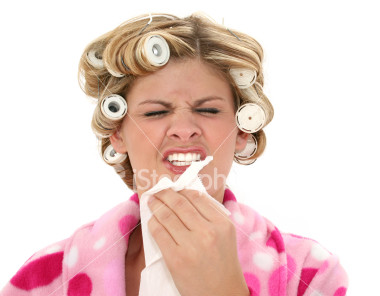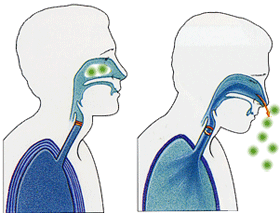Sneezing – Causes, Treatments and Good Sneezing Practices
Key Points:
- Introduction
- What Causes Sneezing?
- What is Photic Sneeze Reflex?
- Are Sneezes Infectious?
- Should You Stifle Your Sneezes?
- Treatments for Conditions that Cause Sneezing
- Good Sneezing Practices
Introduction
All human beings have sneezing in common. Whether you are a loud sneezer or try to muffle it, there are times when you just can’t help but sneeze. For some, sneezing can be a real problem, particularly if they suffer from photic sneeze reflex. Whether your sneezes are caused by allergies or some other reason, sneezes can be embarrassing. They always seem to sneak up on you when you least expect them. Let’s take a look at what causes people to sneeze and how you can treat any conditions that may cause sneezing.
What Causes Sneezing?
There are several reasons that people sneeze. Infrequent sneezes are usually the by-product of small particles that get past your nose hair and irritate the sensitive lining of your nose. You may notice a slight burning or tingling right before or after this type of sneeze.
 When the particle or particles reach this sensitive area of your nose, histamines are triggered and are released into your system. This is what makes you feel as though you have a burning sensation in your nose. This signals your body that it needs to sneeze to expel the particles that are irritating your nose. You may not believe it, but your nose isn’t the only body part involved in a sneeze. The entire response to an allergen or particle involves your chest, face and throat muscles as well as your lungs.
When the particle or particles reach this sensitive area of your nose, histamines are triggered and are released into your system. This is what makes you feel as though you have a burning sensation in your nose. This signals your body that it needs to sneeze to expel the particles that are irritating your nose. You may not believe it, but your nose isn’t the only body part involved in a sneeze. The entire response to an allergen or particle involves your chest, face and throat muscles as well as your lungs.
Other causes of sneezing may include a common cold or the flu. In this instance, your nasal passages are irritated and the same process above is initiated. However, since the burning feeling in your nose does not go away as it would if you had particles irritating your nose, you continue to keep sneezing.
Allergies are probably the most common reason for sneezing. If you have hay fever, you know exactly how much irritation can come from pollen. Other allergens that produce a sneeze response include dust, dust mites or animal dander. For some people, the smell of perfume or other strong chemicals may also induce sneezing.
Environmental factors may also be a cause of infrequent sneezing. Some people have noticed that they have a need to sneeze when walking into a cool building from the hot outdoors. This is caused by a contraction in your mucus membranes in response to the blast of cold air hitting your nose. Another lesson common reason for sneezing is Photic Sneeze Reflex.
What is Photic Sneeze Reflex?
Do you walk outside into sunshine and immediately begin sneezing? If you do, chances are you have Photic Sneeze Reflex. This condition has been recognized since the time of Aristotle and can affect millions of people. Approximately 17 to 35% of the entire world’s population can suffer from this reflex. You may sneeze just once, but many people report sneezing several times in quick succession.
The reason this occurs is due to a congenital malformation of the nerve that controls sneezing. This is called the trigeminal nerve or the fifth cranial nerve. This particular nerve is believed to be responsible for sending visual signals to the brain. If this nerve becomes over-stimulated, Photic Sneeze Reflex may occur.
This is not a dangerous condition, but it can be a little embarrassing, especially if you sneeze several times in a row. Sufferers may also notice that their sneezes are brought on by cold air, or by strong smells. Mint gum seems to be a common trigger for many people.
Are Sneezes Infectious?
Since a sneeze is so powerful, it has long been believed that it is responsible for the spread of disease. Allergic sneezing and Photic Sneeze Reflex will not cause the sufferer to spread disease, but those suffering from a cold or the flu may be able to spread bacteria to others when they sneeze.
 A powerful sneeze can produce nearly 40,000 aerosol droplets which are propelled through the air at great force. The most common estimates for the speed these droplets travel is around 95 mph, but some people may be able to reach 650 mph for their sneezes. This is the main reason that airborne diseases can be so easily spread throughout the populace. When you think about 40,000 infectious droplets being propelled through the air at 95 mph, it paints a pretty clear picture about how far these droplets can go.
A powerful sneeze can produce nearly 40,000 aerosol droplets which are propelled through the air at great force. The most common estimates for the speed these droplets travel is around 95 mph, but some people may be able to reach 650 mph for their sneezes. This is the main reason that airborne diseases can be so easily spread throughout the populace. When you think about 40,000 infectious droplets being propelled through the air at 95 mph, it paints a pretty clear picture about how far these droplets can go.
Should You Stifle Your Sneezes?
Now that we know how infectious sneezes can be a lot of people may want to start stifling them. This is actually very dangerous and should be avoided at all times. Although sneezing can draw unwanted attention to yourself, stifling a sneeze can produce actual bodily harm.
Scientists have found that over time, stifling sneezes can cause irreparable damage to your sinuses, your inner ear and even your brain. The amount of force behind the sneeze is what makes it so dangerous to stifle. Your brain and ears have to deal with a backdraft of pressure that could possibly rupture your eardrum.
If you absolutely must stifle a sneeze, there is a better way to do it. If you feel as though you are about to sneeze try to hold your breath for a few seconds after completely emptying your lungs. This interrupts the process, giving your body no air to expel to create a sneeze. This should not be done often, but works well in an emergency.
Treatments for Conditions That Cause Sneezing
There are no treatments for the occasional sneeze, but if you suffer from allergies there are numerous over the counter medicines that may help. You should visit with your doctor before adding any new medications to your daily routine to ensure that they will not counteract with any other drugs you may be taking. If over the counter pills do not work, you may need a stronger prescription medicine for allergy sufferers.
Antihistamines work by suppressing the flow of histamines that cause your body to start the sneezing process. You won’t have the symptoms of a burning or tingling nose and your body won’t need to react by expelling air. These pills also work quite well for Photic Sneeze Reflex sufferers in some cases.
If you are suffering from a cold or the flu, over the counter cold medication may reduce the amount of sneezing. This is important to make sure that you don’t continue to spread the disease.
Good Sneezing Practices
If you absolutely have to sneeze, make sure that you use a tissue and not your hands. When you think about how many things you touch throughout the day, it’s easy to see how disease can be spread. By blowing 40,000 infectious particles into your hands, you are setting up a perfect contamination zone that can infect nearly everyone around you.
It is a good idea to use a disposable tissue paper when you sneeze, and if necessary, at least two. Try to find a brand that won’t shred, since they won’t spread disease as easily. When you are done with your tissue, fold or crinkle it up and properly dispose of it. It is important to wash your hands or use hand sanitizer after you sneeze or dispose of any soiled tissue paper. This will cut down on the amount of germs on your hands.
By using good sneezing practices you can cut down on the spread of an outbreak, particularly during winter months and other infectious periods of the year.
This article is the property of http://www.HealthHype.com
Copying and publishing any article from our site is strictly NOT allowed





